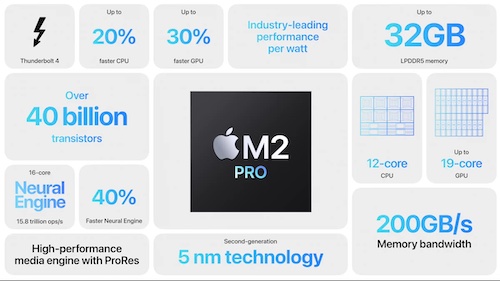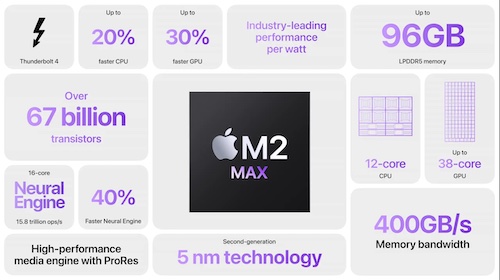It’s time to make a comparison between the M2, M2 Pro and M2 Max. With the announcement of the M2 Pro and M2 Max, Apple is delivering the next-generations of SoCs (systems-on-a-chip) for the public market. Concerning these new chips, the amount of power both of them contain is far greater than the Intel-based chips of the past, while also being considerably more powerful than Apple’s M2.
Along with taking a look at the new M2 Pro and the M2 Max, these two chips will be compared alongside the M2. Taking a look at the specs, users can determine for themselves what chip suits their needs the best. While the new M2 Pro and M2 Max are extremely powerful, there are certain things one should consider when determining what is best for them.
The M2 Pro: Better, Stronger and Faster
When it comes to the M2 Pro, the chip itself consists of 40 billion transistors, which is nearly double from the M2. The M2 also features 200GB/s of unified memory bandwidth, which is also double of the M2, while also including 32GB of low-latency unified memory. This can be great in, say, a MacBook Pro. 
(Photo Credit: Apple.)
Concerning the CPU, the new M2 Pro can support either 10- or 12-core, which can consist of up to eight high-performance cores alongside four high-efficiency cores. This “multithreaded” CPU performance means the M2 Pro is capable of reaching speeds that are 20% faster than that of the M1 Pro and its 10-core CPU. This means users are able to run heavier workloads, especially in CPU-intensive apps, such as Photoshop.
Additionally, the new M2 Pro is capable of seeing configurations of up to 19 cores, while also including a larger L2 Cache (though Apple does not provide specifics). The new M2 Pro is capable of reaching speeds that are 30% faster than the M1 Pro, while also being significantly faster than the M2. The new GPU in the M2 Pro is capable of higher image processing performance, which will be a massive help in delivering “console-quality gaming”.
The M2 Max: New Frontiers in Chip Design
Alongside the new M2 Pro is also the new M2 Max. Featuring 67 billion transistors, which is 3x more than the M2, the new M2 Max is brining new plateaus to the world of Apple silicon. The new M2 Max also features 400GB/s of unified memory bandwidth, which is four times greater than the capacities of the M2, while also supporting up to 96GB of fast unified memory. In thanks to this upgrade to memory, the M2 Max is capable of handling files that are absolutely massive, while also allowing users to work across multiple memory-intensive apps with speed and agility.
(Photo Credit: Apple.)
Similar to the M2 Pro, the M2 Max also features the same 12-core CPU. However, the GPU in the M2 Max is able to support a whopping 38 cores, while also pairing itself with a larger L2 cache. Concerning the new MacBook Pro that will feature the M2 Max, the 96GB of memory will help push graphically-intense programs into the next dimension in thanks to the new SoC. The new M2 Max is so powerful, Apple has no qualms stating that it is the “world’s most powerful and efficient chip for a pro laptop”.
Making Comparisons Between the M2, M2 Pro and M2 Max
Additionally, both the M2 Pro and M2 Max feature updates to certain custom technologies. This includes both the M2 Pro and M2 Max featuring Apple’s next-gen 16-core Neural Engine. This new Engine is capable of delivering 15.8 trillion operations per second, which is 40% faster than the operation capabilities the previous generation of chips.
| M2 | M2 Pro | M2 Max | |
| Transistor Count | 20 Billion | 40 Billion | 67 Billion |
| Manufacturing Technology | 5nm | 5nm | 5nm |
| Unified Memory | 8GB, 16GB , 24GB | 16GB, 32GB | 32GB, 64GB, 96GB |
| Memory Bandwidth | 100 GBps | 200GBps | 400GBps |
| GPU Cores | 8 or 10 | 16 or 19 | 30 or 38 |
| CPU Cores | 8 (4 performance, 4 efficiency) | 10 or 12 (6/8 performance, 4 efficiency) | 12 (8 performance, 4 efficiency) |
| Neural Engine | 16-Core | 16-Core | 16-Core |
Furthemore, the M2 Pro also features a new media engine, which features a hardware-accelerated H.264, HEVC and ProRes video with encode and decode. This new media engine allows for multiple streams of both 4K and 8K ProRes video while consuming very little power. In terms of the M2 Max, it features two video encode engines alongside two ProRes engines, delivering double the video encoding over the M2 Pro.
For both the M2 Pro and M2 Max, both also feature Apple’s latest image signal processor, which helps with noise reduction. The new signal processor also implements computational video to enhance the camera image quality in thanks to a Neural Engine. Both also feature a next-generation Secure Enclave, which Apple declares is a “critical part” of its security.
Energy Efficiency
Lastly, both the new M2 Pro and M2 Max are also extraordinarily energy efficient, meeting the high standards Apple maintains. For example, the next-generation of Apple silicon is capable of powering the 2023 MacBook Pro for 22 hours—some of the longest battery life to ever be found in a Mac. Of course, both chips are also meant to work alongside macOS, especially macOS Ventura.
Conclusion: Choosing the M2 Over the M2 Pro or M2 Max
When it comes to the power of a chip, different needs will suit different folks. While the new M2 Max sounds like an absolute monster, that doesn’t necessarily mean it is something everyone needs. When determining what chip is right for you, think about what you use your machine for: are you processing images and editing video all day, or constantly trying to game? A speedier chip may be just what you need. However, if you’re the type that uses their machine more for surfing the internet and answering emails, you may not need the most-powerful and greatest.
Either way, the new M2 Pro and M2 Max are certainly more than capable of delivering high-quality performance for your machine. Taking a look at the specs, determine for yourself what you believe will best suit your needs.
